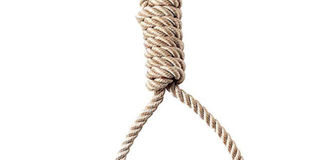
This file photo taken on February 29, 2000 shows the "death chamber" at the Texas Department of Criminal Justice Huntsville Unit in Huntsville, Texas
The possible execution of Margaret Nduta, 37, set for Monday in Ho Chi Minh, Vietnam, has sparked an online debate, with Kenyans pleading with the government to act swiftly and avert their compatriot’s impending death in a foreign land.
Alongside this anxiety-filled conversation, the topic of execution as a just means of punishment for capital crimes has taken the centre-stage, with Kenyans arguing that Ms Nduta should be repatriated to Nairobi, and her sentence transmuted to life imprisonment.
It is highly likely that the condemned Kenyan, who was found guilty of trafficking over 2 kilos of cocaine, will be executed by lethal injection.

Macharia Margaret Nduta, 37, has been sentenced to death in Vietnam.
But what exactly is execution?
Execution, in the context of administration of justice, is the carrying out of a sentence of death on a condemned person, and here are the various forms that it takes.
Lethal injection
The Death Penalty Information Centre (DPIC) defines lethal injection as a method of execution involving the administration of one or more drugs to induce death, primarily used for capital punishment.
It is a method commonly used by countries that still practice the execution of offenders who commit a felony.
The most traditional method of administering a lethal injection is the three-drug protocol where an anaesthetic to induce unconsciousness is first used, followed by a paralytic agent to prevent movement, then finally, another drug is used to stop the heart.

The execution chamber at the Southern Ohio Correctional Facility in Lucasville, Ohio
The other methods used to administer lethal injection is the one or two-drug protocol which involves the use of an anaesthetic or sedative.
It is widely believed that the lethal injection was developed in the 1970s by Dr Jay Chapman following a request by Oklahoma legislators who asked him to design a more humane form of execution than the ones previously used.
The condemned person is usually bound to a gurney and a member of the execution team places numerous heart monitors in the skin.
Two needles, one a back-up, are then inserted into veins, normally in the prisoner’s arms. Long tubes then connect the needle through a hole in a cement block wall to several intravenous drips.
The first is a harmless saline solution that is started immediately. At the warden’s signal, a curtain is raised exposing the prisoner to witnesses in an adjoining room.
Use of electric chair
History narrations suggest that in the late 1880s, the use of an electric chair for the death penalty was first adopted in the US by the New York State.
It was mainly argued that it was a more humane form of dying compared to hanging where offenders would at times take unnecessarily long before dying.
Dentist Alfred P. Southwick is believed to have developed the idea of using electricity to carry out the death penalty as early as 1881 but it was adopted as the newest method of execution in 1889 in New York.
On August 6, 1890, William Kemmier, convicted of murder, was the first to be electrocuted and had to be shocked again when he returned to consciousness after the initial shock.
Four years later, Lizzie Halliday, a convicted serial killer, became the first woman to be sentenced to death by electricity but her sentence was later changed to life in prison.
From there, the use of electricity became adopted across various countries across the world.
For it to happen, the person, blindfolded, is usually shaved and strapped to a chair with belts crossing his/her chest, groin, legs and arms.
A metal-skull-shaped electrode is attached to the scalp and forehead over a sponge with moistened saline.
An additional electrode is moistened with conductive jelly and attached to a portion of the prisoner’s leg that has been shaved to reduce resistance to electricity. Electric current is then switched on.
Firing squad
This is a method of capital punishment where a condemned person is killed by a group of shooters firing rifles simultaneously on command.
Oftentimes, it is used in military contexts, and at times, as a legal punishment. In the past, this method was called fusillading, a word coined from the French word “fusil”, which means rifle.
Often, it was used in the military for crimes such as desertion or cowardice but over time became adopted in the civilian world through the courts.
It was most common in countries with a history of military leadership or wars.
The main argument for its use was that guns were readily available and that a single gunshot to a vital organ such as the heart or brain would kill relatively fast.
For its execution, several shooters are involved in the process to prevent the disruption of the process by one member as well as the identification of who fired the fatal shot.
The shooters are usually also instructed to aim for the heart to avoid disfigurement should they aim for the head.
Normally, the convict is placed a few metres from the shooters and his/her head is covered during the execution.
Gas chamber
This method was first introduced in 1924 in the state of Nevada, US, where the use of cyanide gas was adopted as a more humane form of execution of its condemned prisoners.
A man identified as Gee Jon was the first to be executed by this method where the lethal gas was pumped into his cell while he slept.
However, the gas leaked from his room posing a risk to others and this resulted in the creation of the gas chamber.
Whereas several countries have gas chambers, often, they have lethal injection as an alternative method.
For a convicted person to be killed using this method, he/she is strapped to a chair in an airtight chamber.
Below the chair is a pail of sulphuric acid. Once everyone has left the chamber, the warder gives a signal to the executioner who flicks a lever that releases crystals of sodium cyanide into the pail.
This causes a chemical reaction that releases the portent hydrogen cyanide gas.
The prisoner is usually instructed to breathe deeply to speed up the process. Records however show many prisoners try to hold their breath and struggle.
A long stethoscope is also affixed to the prisoner so that a doctor outside can pronounce death.
Hanging
This was the most common method of execution until the 1890s.
For this method to work, the prisoner is usually weighed a day before the execution and a rehearsal done using a sandbag of the same weight as the prisoner.
This is done to determine the length of “drop” necessary to ensure quick death. A very long rope would result in the prisoner being decapitated and one too short will delay the strangulation for up to 45 minutes.
Also Read: I did not intend to kill… I’m banking on you, pleads Kenyan facing execution in Saudi Arabia
The rope used is usually between three-quarter inch to one and a quarter inch in diameter and must be boiled and stretched to eliminate spring or coiling. The knot should also be lubricated with wax or soap.

Many on death row do not have the financial capacity to access adequate legal representation. FILE PHOTO
Before the execution, the prisoner’s hand and legs are tied, he/she is blindfolded and the noose is placed around the neck, with the knot behind the left ear.
DPIC explains that for this execution to happen, a trap-door is opened and the prisoner falls through. The prisoner’s weight should cause a rapid fracture-dislocation of the neck.
Rarely does instant death occur using this method.
In Kenya, it is believed that the last execution by hanging was carried out in 1987 against John Ochuka, Pancras Oteyo Okumu and two other masterminds of the botched 1982 putsch against the late President Daniel Moi, who were convicted for the offence of treason.
World over, several humanitarian organisations continue to campaign for the abolishment of the death penalty.
In Kenya, thousands have been sentenced to death for various capital offences but no one has actually been executed since 1987.
For the last 38 years, these convicts have been left dreading the possibility of every day being their last.
Regional
Kenya is among 22 countries in Africa that are yet to abolish the death penalty but have not carried out any executions in the last decade, according to Amnesty International.
Among the biggest campaigners against the death penalty is the International Commission of Jurists, (ICJ) which, including its Kenyan section, actively lobby for the abolition of this punishment, urging governments to establish moratoriums and in the tail-end, do away with capital punishment.
For Julie Wayua, Programmes Manager, ICJ-Kenya, the 615 people executed globally for drug-related offences, particularly in China, North Korea and Vietnam, is a number too high.
Considering that, at least 40 per cent of all executions between 2014 and 2024 globally are drug-related, according to the Harm Reduction International, Ms Wayua emphasised the need for countries with capital punishment for drug-related offences to reconsider their stance.
For her, the death penalty, under the International Convention on Civil and Political Rights, should only be imposed on the most serious crimes.
"We, ICJ- Kenya, opine that whereas drug-related offences are serious, they do not constitute the most serious crimes. Further, the imposition of the death penalty, for us, is a continued deprivation to the right of life which is sacrosanct and also a violation to the Universal Declaration of Human Rights," she said.
She urged the Kenyan government to act with speed since a life is in line, and work to ensure that Ms Nduta is repatriated to the country to face the criminal justice system within the country "where she does not get sentenced to death".
"This is an urgent matter and we call on all stakeholders to treat it as such", she said.
In 2023, former Ugunja MP, and current National Treasury Cabinet Secretary, Opiyo Wandayi, presented the Penal Code (Amendment) Bill before the floor of the National Assembly.
The amendment targets several laws— including the Prison Act, the Legal Aid, the Kenya Defence Forces Act, the Preservation of Public Security and Appellate Jurisdiction Act, with regards to the death penalty.
“The law provides that when a person is sentenced to death, ‘he shall be hanged by the neck until he is dead’. This not only demonstrates the torturous and archaic nature of the death penalty, but also warrants its urgent and immediate abolition as a form of punishment in Kenya,” Mr Wandayi said.









